 Open Access
Open Access
ARTICLE
Generation of Low-Delay and High-Stability Multicast Tree
1 School of Computer Science and Technology, Hainan University, Haikou, Hainan, 570228, China
2 School of Cyberspace Security (School of Cryptology), Hainan University, Haikou, Hainan, 570228, China
3 Faculty of Arts, University of British Columbia, Vancouver, V6T1Z4, Canada
* Corresponding Author: Jiangyuan Yao. Email:
Computers, Materials & Continua 2023, 76(1), 561-572. https://doi.org/10.32604/cmc.2023.033332
Received 14 June 2022; Accepted 30 January 2023; Issue published 08 June 2023
Abstract
Delay and stability are two key factors that affect the performance of multicast data transmission in a network. However, current algorithms of tree generation hardly meet the requirements of low delay and high stability simultaneously. Given a general network, the generation algorithm of a multicast tree with minimum delay and maximum stability is an NP-hard problem, without a precise and efficient algorithm. To address these challenges, this paper studies the generation of low-delay and high-stability multicast trees under the model of spanning tree based on stability probability, degree-constrained, edge-weighted for multicast (T-SDE). A class of algorithms was proposed which creates the multicast tree greedy on the ratio of fan-out to delay (RFD) and probability of stability of terminal to obtain a high performance in multicast. The proposed algorithms greedily select terminals with a large RFD and a high probability of stability as forwarding nodes in the generation of the multicast tree, where the larger RFD and higher stability of upstream nodes are beneficial to achieve a low transmission delay and high stability in multicast. The proposed RFD can be compatible with the original model, which can take advantage of network connectivity during the generation of a multicast tree. This paper carries out simulation experiments on Matlab R2016b to measure the performance of the proposed algorithm. Experimental results show that the proposed algorithm can provide a smaller height, higher stability, and a lower transmission delay of the resulting multicast tree than other solutions. The spanning tree of the proposed algorithms can support low transmission delay and high stability in multicast transmission.Keywords
Multicast can achieve efficient data transmission for group receivers [1,2], which is widely used in various types of networks, such as the Internet [3,4], overlay networks [5], data center networks (DCNs) [6–8], and Internet-of-Things (IoT) [9–11]. Most related work constructs multicast trees to reduce transmission delay or improve multicast stability [12]. However, few works study the generation of multicast trees with low delay and high stability at the same time [13], which is a crucial challenge to be addressed in future multicast deployment.
Given a general network structure, it is a non-deterministic polynomial-hard (NP-hard) problem to construct a multicast tree with minimum delay as in [14,15]. Similarly, the construction of a multicast tree with maximum stability is also an NP-hard problem, which can be proven through the reducible principle in a polynomial time [16,17]. Without an enumeration algorithm, there is no precise solution to the minimum delay and maximum stability challenges. However, the enumeration algorithm suffers from excessive complexity, which hardly meets the practical application requirements.
To construct a high-performance multicast tree, this paper focuses on the generation of a low-delay and high-stability tree under the model of spanning tree based on stability probability, degree-constrained and edge-weighted for multicast (T-SDE) [13]. T-SDE presents a realistic multicast scenario and provides a class of algorithms on the contribution of links (
This paper proposes a class of low-delay and high-stability generation algorithms of the multicast tree, which can take advantage of the degree and connectivity of a terminal. Firstly, this paper defines the ratio of fan-out to delay (
The main difference between this paper and other related work lies in the following two parts. Firstly, both the stability and delay of the multicast tree are considered in this paper. Secondly, this paper considers the change in node connectivity during the generation of a multicast tree. This paper makes three contributions as follows. First, the ratio of fan-out
The rest of this paper is organized as follows. Sections 2 and 3 present the related work of multicast and the background of this paper. Section 3 proposes the
IP multicast is the first proposed mechanism that implements the function of data replication and forwarding at the network layer of Internet [1]. The possibility was [18] explored for the crowdsourced service-less video multicast in the fifth-generation (5G) radio access network (RAN), which proposes a viable solution using network function virtualization and mobile edge computing. To improve vehicle-to-vehicle collaboration in the network layer, a novel multicast protocol [19] was proposed which was specifically designed for streaming service over vehicular networks. Due to high mobility and rapid topology changes, a novel distributed tree-based multicast routing algorithm was proposed [20], which takes link failure into account. For the first time, the multicast delay was explored under a general cooperative multicast scheme [21], which proposed a two-hop relay multicast algorithm.
The key idea of the application layer multicast is to implement the function of data forwarding by terminals at the application layer among group users [6], which does not require exceptional support from routers. This multicast model does not need to change the existing network infrastructure, while the forwarding terminals bring the problem of stability and delay of the resulting multicast tree. It is a key challenge to create a low-delay and high-stability tree, which severely affects the multicast performance in overlay network multicast [12,13,16].
Multicast in data center networks focuses on the generation of the multicast tree, route management, and dynamic migration of group members. Shahbaz et al. [22] takes advantage of programmable switches and features of data center networks to improve the scalability in multi-tenant multicast. With limited storage space in a switch, [23] introduces a multi-class Bloom Filter, which supports a large amount of multicast group information. To save multicast forwarding entries in switches, a novel multicast membership management scheme was designed [24] for data center networks, which leverages the characteristics of multicast applications and software-defined networking techniques. To address scalable and load-balancing challenges, a scalable load-balanced multicast source routing was proposed for large-scale data centers [25], which can achieve a better multicast load balance than other existing schemes. Both service function chain and end-to-end delay requirements in a mobile edge cloud, [26] devised an approximation algorithm and an efficient heuristic. To deal with a huge increment of multicast flows, a preemptive scheduling approach was presented to reduce flow transmission time [27].
This section introduces the background of our work, including the T-SDE model, stability metric and transmission delay in multicast tree construction.
T-SDE [13] comprehensively considers the factors that affect the multicast quality, which is built on the abstraction of the overlay network. In the construction of a multicast tree, the T-SDE model can reflect the characteristics of the network, which focuses on stability probability, constrained degree, and weighted edge. The T-SDE model was defined as follows [13]:
Given an undirected and connected graph
The transmission interruption of a reception terminal
In the above expression (1),
To measure the impact of stability probability on multicast accurately without other factors, a stability degree probability factor (
The reception delay of
The multicast tree is constructed on the contribution link (CL) and the probability of stability
This section first analyzes the contribution of a forwarding terminal in multicast tree construction, then presents the algorithm and analysis of our generation method.
4.1 Contribution of Forwarding Terminal
Based on the above research analysis, this paper first defines the contribution of forwarding terminals. For the sake of description, this paper first presents a few symbols as shown in Table 1.

T-SDE deploys
This definition considers out-degree constraint
From the construction of a multicast tree, we learn that only the edge and terminal interconnected with the current terminal
In the above expression (4),
In multicast tree construction, the measurement
To facilitate description, this article defines some symbols in the process of tree generation. Let an undirected and connected graph
In the construction of a multicast tree, vertices in
The construction algorithm selects vertice from

Algorithm 1 is built on
To take advantage of the
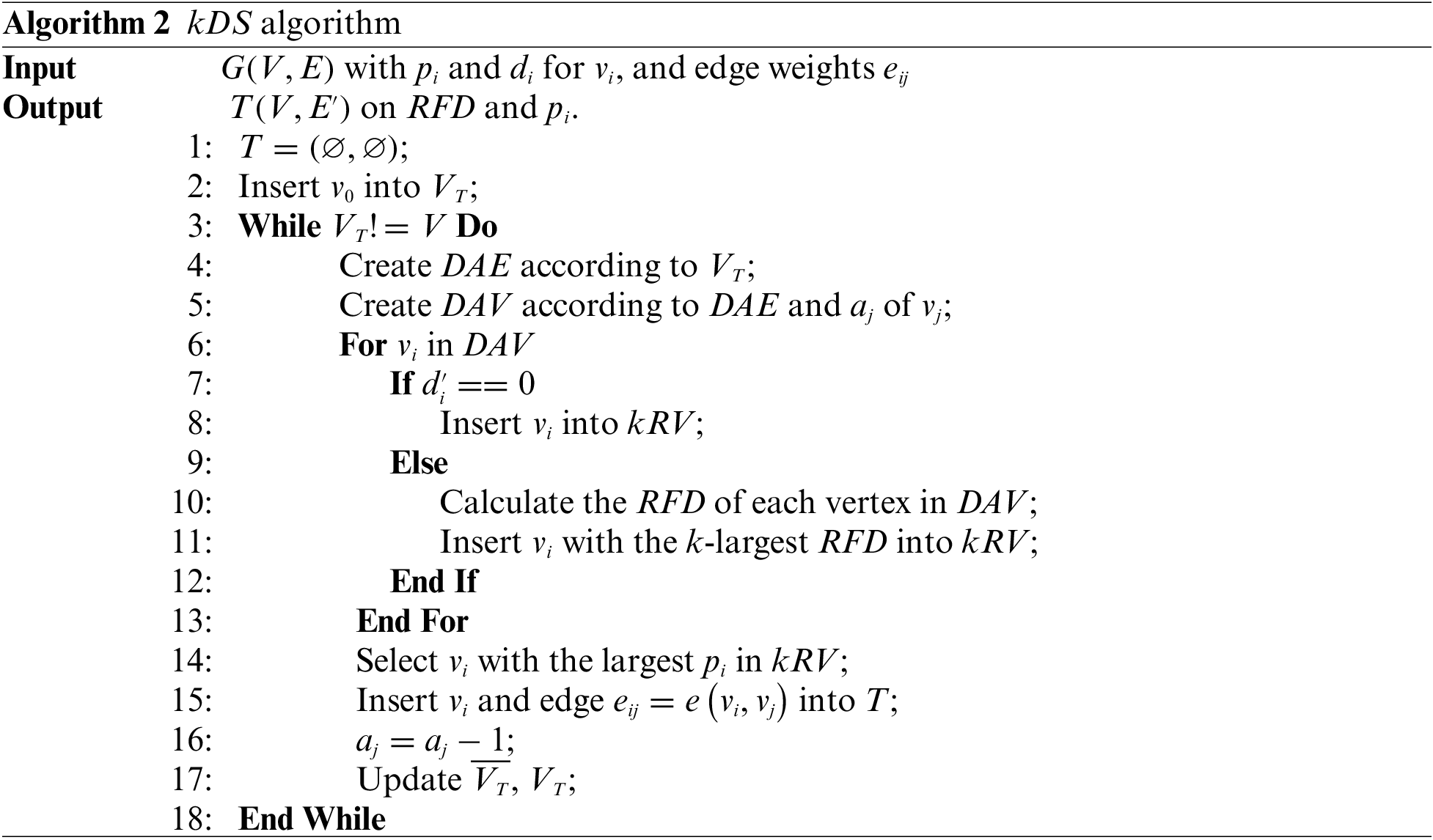
Algorithm
These algorithms take advantage of the connectivity and stability of each vertex to construct a high-performance tree, which fully considers the change in network connectivity.
4.3 Analysis of the Construction Algorithm
Based on
Both the
This section presents the comparison of various multicast trees in terms of stability and delay.
We carry out simulation experiments on Matlab R2016b to measure the performance of the proposed algorithm. Given an average number of neighbors, experiments are conducted in various networks to measure the properties of the multicast tree. This paper deploys the same experimental settings as [13]. Each vertex has 10 neighbors on average. For each
We describe the experimental result in this section. Fig. 1 shows that with the increment of network scale, where the resulting tree of the algorithm
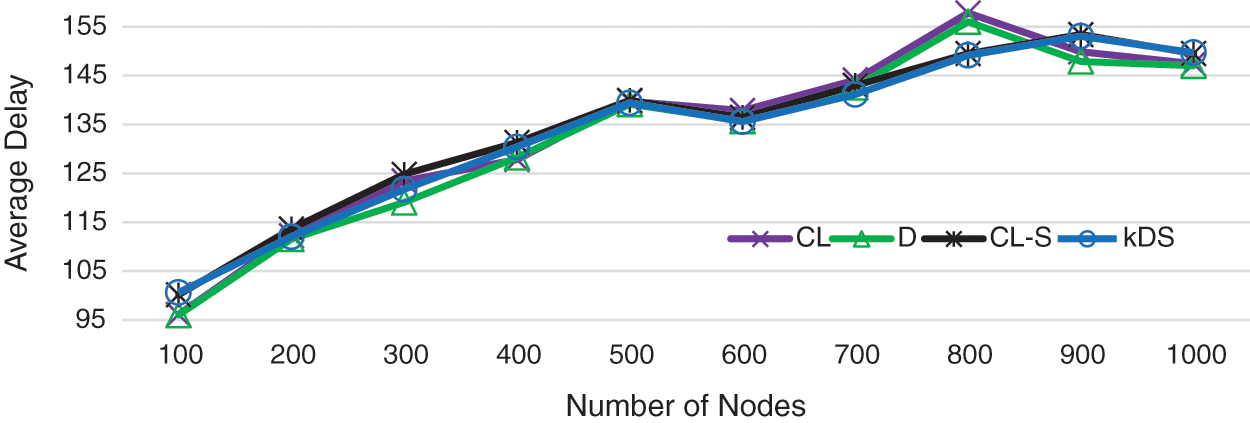
Figure 1: The average delay of multicast on the network scale
Fig. 2 shows the relationship of the maximum delay on the network scale. As we can see, with the increment of network scale, both algorithms
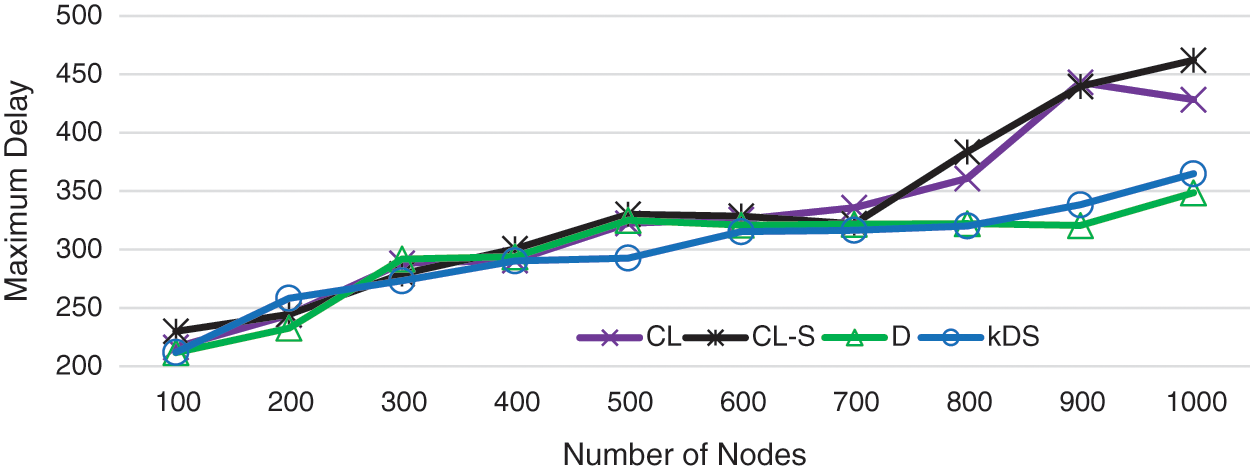
Figure 2: The maximum delay of multicast on the network scale
Fig. 3 shows that the height of the multicast tree gradually increases with the increment of the network scale. The resulting tree in algorithm
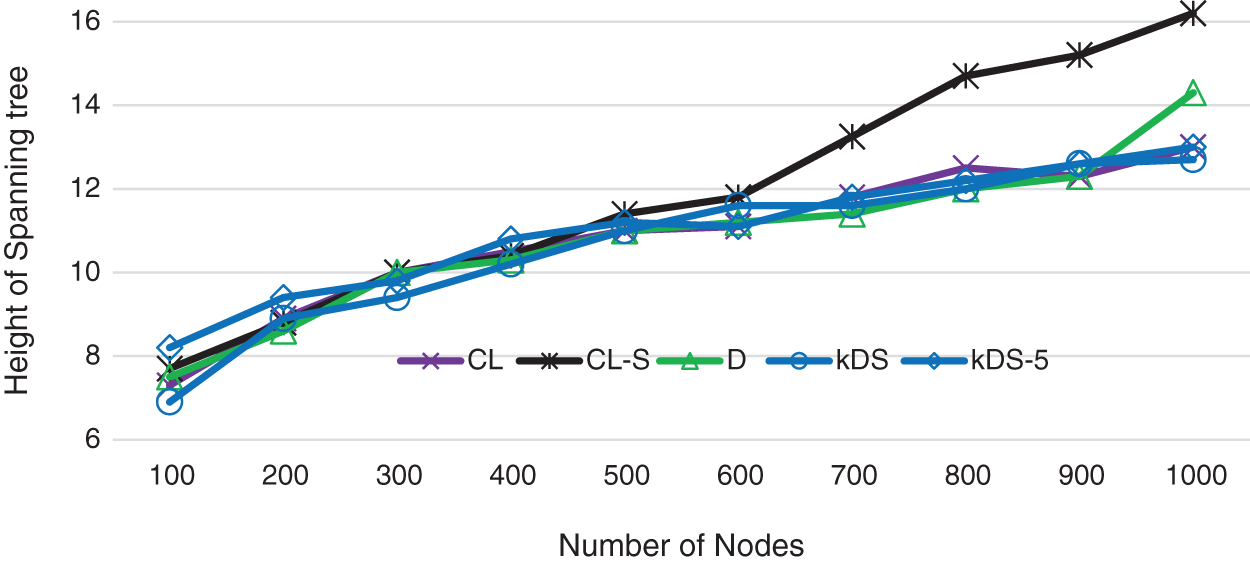
Figure 3: The height of the spanning tree on the network scale
Fig. 4 shows the relationship between the stability of multicast and network scale. We can see that algorithm
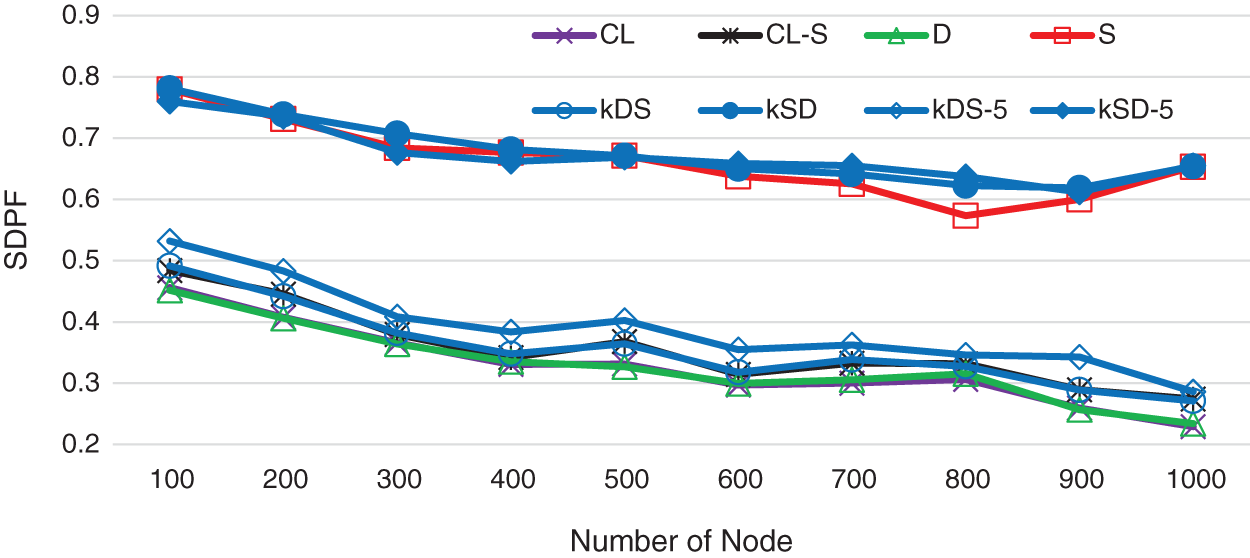
Figure 4: The SDPF on the network scale
Experimental results show that the average delay of the multicast tree in algorithm
Algorithms in the T-SDE model hardly reflect the change in network connectivity in multicast tree generation. This paper studied the construction algorithm of a low-delay and high-stability multicast tree in the T-SDE model, and algorithms based on
Funding Statement:: This work was supported by the Hainan Provincial Natural Science Foundation of China (620RC560, 2019RC096, 620RC562), the Scientific Research Setup Fund of Hainan University (KYQD(ZR)1877), the National Natural Science Foundation of China (62162021, 61802092, 82160345, 61862020), the key research and development program of Hainan province (ZDYF2020199, ZDYF2021GXJS017), and the key science and technology plan project of Haikou (2011-016).
Conflicts of Interest: The authors declare that they have no conflicts of interest to report regarding the present study.
References
1. S. Deering, “Multicast routing in internetworks and extended LANs,” ACM Transactions on Computer System, vol. 8, no. 2, pp. 85–110, 1990. [Google Scholar]
2. Y. Dong, L. Song, R. Xie and W. Zhang, “ltra-low latency, stable, and scalable video transmission for free-viewpoint video services,” IEEE Transactions on Broadcasting, vol. 68, no. 3, pp. 636–650, 2022. [Google Scholar]
3. W. Wu, J. Liu and T. Huang, “The source-multicast: A sender-initiated multicast member management mechanism in SRv6 networks,” Journal of Network and Computer Applications, vol. 153, no. 3, pp. 102505, 2020. [Google Scholar]
4. Q. Liu, H. Ren, R. Tang and J. Yao, “Optimizing co-existing multicast routing trees in IP network via discrete artificial fish school algorithm,” Knowledge Based Systems, vol. 191, no. 3, pp. 105276, 2019. [Google Scholar]
5. Y. Chu, S. Rao and H. Zhang, “A case for end system multicast,” IEEE Journal on Selected Areas in Communications, vol. 20, no. 8, pp. 1456–1471, 2002. [Google Scholar]
6. M. Shahbaz, L. Suresh, J. Rexford, N. Feamster, O. Rottenstreich et al., “Elmo: Source routed multicast for public clouds,” IEEE/ACM Transactions on Networking, vol. 28, no. 6, pp. 2587–2600, 2020. [Google Scholar]
7. D. Li, H. Cui, Y. Hu, Y. Xia and X. Wang, “Scalable data center multicast using multi-class Bloom Filter,” in Proc. 2011 19th IEEE Int. Conf. on Network Protocols, Vancouver, BC, Canada, pp. 266–275, 2011. [Google Scholar]
8. K. Ambika and M. B. Moses, “Tar-aft: A framework to secure shared cloud data with group management,” Intelligent Automation & Soft Computing, vol. 31, no. 3, pp. 1809–1823, 2022. [Google Scholar]
9. E. Garro, M. Fuentes, J. Carcel, H. Chen D. Mi et al., “5G mixed mode: NR multicast-broadcast services,” IEEE Transactions on Broadcasting, vol. 66, no. 2, pp. 390–403, 2020. [Google Scholar]
10. J. Almutairi and M. Aldossary, “Exploring and modelling IoT offloading policies in edge cloud environments,” Computer Systems Science and Engineering, vol. 41, no. 2, pp. 611–624, 2022. [Google Scholar]
11. K. Imran, N. Anjum, S. Mahfooz, M. Zubair, Z. Yang et al., “Cluster-based group mobility support for smart IoT,” Computers, Materials & Continua, vol. 68, no. 2, pp. 2329–2347, 2021. [Google Scholar]
12. J. Su, J. Cao and B. Zhang, “A survey of the research on ALM stability enhancement,” Chinese Journal of Computers, vol. 32, no. 3, pp. 576–590, 2009. [Google Scholar]
13. L. Huo, D. Li and Y. Tan, “Algorithms of spanning tree based on the stability probability and contribution link of nodes for ALM,” Journal of Computer Research and Development, vol. 49, no. 12, pp. 2559–2567, 2012. [Google Scholar]
14. E. Brosh, A. Levin and Y. Shavitt, “Approximation and heuristic algorithms for minimum-delay application-layer multicast trees,” IEEE/ACM Transactions on Networking, vol. 15, no. 2, pp. 473–484, 2007. [Google Scholar]
15. S. Shi and JS. Turner, “Multicast routing and bandwidth dimensioning in overlay networks,” IEEE Journal on Selected Areas in Communications, vol. 20, no. 8, pp. 1444–1455, 2002. [Google Scholar]
16. V. Roca and A. El-Sayed, “A host-based multicast (HBM) Solution for group communications,” in Proc. of the 1st Int. Conf. on Networking, Colmar, France, pp. 610–619, 2001. [Google Scholar]
17. G. Tan and S. A. Jarvis, “Improving the fault resilience of overlay multicast for media streaming,” IEEE Transactions on Parallel and Distributed Systems, vol. 18, no. 6, pp. 721–734, 2007. [Google Scholar]
18. K. Zahoor, K. Bilal, A. Erbad and A. Mohamed, “Service-less video multicast in 5G: Enablers and challenges,” IEEE Network, vol. 34, no. 3, pp. 270–276, 2020. [Google Scholar]
19. D. R. Chowdhury, S. Nandi and D. Goswami, “Video streaming over IoV using IP multicast,” Journal of Network and Computer Applications, vol. 197, no. 3, pp. 103259, 2022. [Google Scholar]
20. S. Babu and A. R. K. Parthiban, “DTMR: An adaptive distributed tree-based multicast routing protocol for vehicular networks,” Computer Standards & Interfaces, vol. 79, no. 2, pp. 103551, 2022. [Google Scholar]
21. B. Yang, Z. Wu, Y. Shen and S. Shen, “On delay performance study for cooperative multicast MANETs,” Ad Hoc Networks, vol. 102, no. 4, pp. 102117, 2020. [Google Scholar]
22. M. Shahbaz, L. Suresh, J. Rexford, N. Feamster, O. Rottenstreich et al., “Elmo: Source routed multicast for public clouds,” IEEE/ACM Transactions on Networking, vol. 28, no. 6, pp. 2587–2600, 2020. [Google Scholar]
23. D. Li, H. Cui, Y. Hu, Y. Xia and X. Wang, “Scalable data center multicast using multi-class bloom filter,” in Proc. of the 19th IEEE Int. Conf. on Network Protocols, Vancouver, BC, Canada, pp. 266–275, 2011. [Google Scholar]
24. Y. Cheng, D. Li, J. Zhu, H. Liu, K. Chen et al., “Managing multicast membership for software defined data center network,” in Proc. of the IEEE 92nd Vehicular Technology Conf. (VTC2020-Fall), Victoria, Canada, pp. 1–5, 2020. [Google Scholar]
25. J. Alqahtani, B. Hamdaoui and R. Langar, “Ernie: Scalable load-balanced multicast source routing for cloud data centers,” IEEE Access, vol. 9, pp. 168816–168830, 2021. [Google Scholar]
26. H. Ren, Z. Xu, W. Liang, Q. Xia, P. Zhou et al., “Efficient algorithms for delay-aware NFV-enabled multicasting in mobile edge clouds with resource sharing,” IEEE Transactions on Parallel and Distributed Systems, vol. 31, no. 9, pp. 2050–2066, 2020. [Google Scholar]
27. L. Luo, K. Foerster, S. Schmid and H. Yu, “Optimizing multicast flows in high-bandwidth reconfigurable datacenter networks,” Journal of Network and Computer Applications, vol. 203, no. 4, pp. 103399, 2022. [Google Scholar]
28. H. Zhang, X. Shi, X. Yin, Z. Wang, H. Geng et al., “DA&FD-deadline-aware and flow duration-based rate control for mixed flows in DCNs,” IEEE/ACM Transactions on Networking, vol. 27, no. 6, pp. 2458–2471, 2019. [Google Scholar]
29. M. Beshley, N. Kryvinska, H. Beshley, M. Medvetskyi L. Barolli et al., “Centralized qos routing model for delay/loss sensitive flows at the sdn-IoT infrastructure,” Computers, Materials & Continua, vol. 69, no. 3, pp. 3727–3748, 2021. [Google Scholar]
30. A. Latif, R. Parameswaran, S. Vishwarupe, A. Khreishah, Y. Jararweh et al., “MediaFlow: Multicast routing and in-network monitoring for professional media production,” IEEE Transactions on Network and Service Management, vol. 19, no. 2, pp. 1862–1875, 2022. [Google Scholar]
Cite This Article
 Copyright © 2023 The Author(s). Published by Tech Science Press.
Copyright © 2023 The Author(s). Published by Tech Science Press.This work is licensed under a Creative Commons Attribution 4.0 International License , which permits unrestricted use, distribution, and reproduction in any medium, provided the original work is properly cited.


 Submit a Paper
Submit a Paper Propose a Special lssue
Propose a Special lssue View Full Text
View Full Text Download PDF
Download PDF Downloads
Downloads
 Citation Tools
Citation Tools